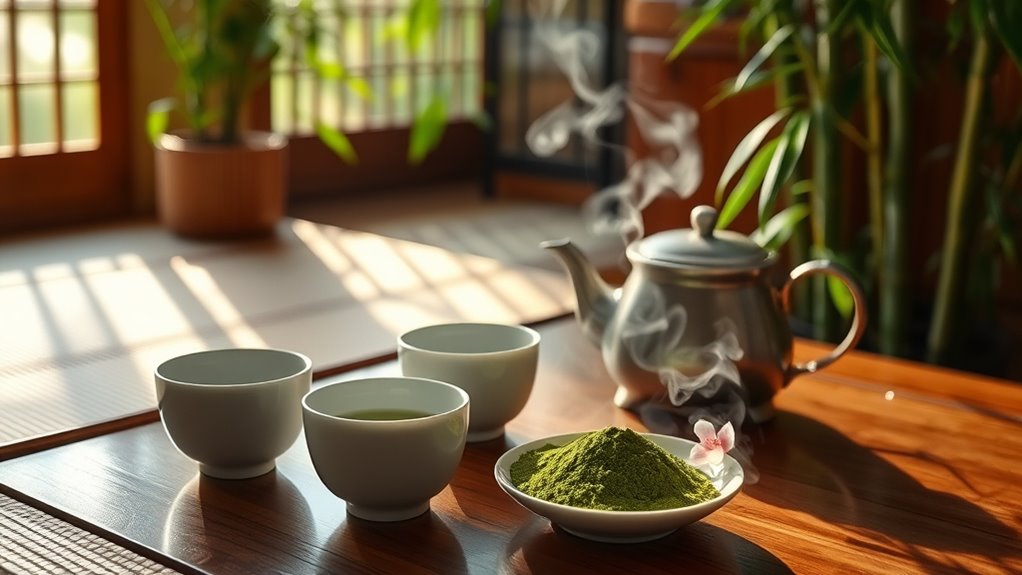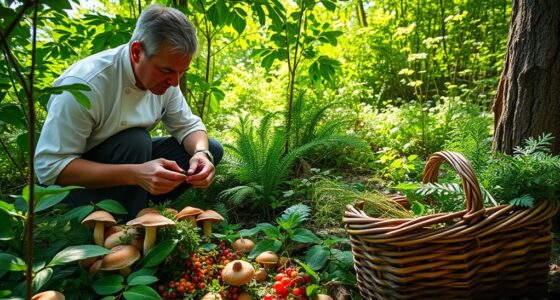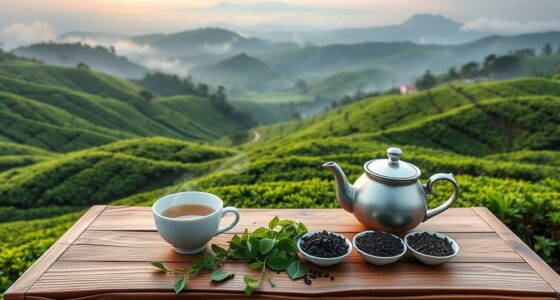When you experience tea tasting in Japan, you immerse yourself in a vibrant cultural tradition. You’ll savor various tea varieties, including popular selections like Sencha and Matcha, each with unique flavors. Engaging in a traditional tea ceremony, you’ll appreciate the meticulous preparation and mindfulness involved. This not only enhances your tasting but also connects you deeply with Japanese customs. Discover how regional differences and seasonal influences play a role, enriching your journey through Japan’s tea culture.
Key Takeaways
- Tea tasting in Japan offers an immersive experience, allowing participants to explore various regional teas and their unique flavors and aromas.
- Guided tastings provide insights into brewing techniques, enhancing appreciation for the craftsmanship behind each tea variety.
- Participants engage in cultural exchange, learning about the historical importance of tea and its role in Japanese society.
- The experience promotes mindfulness and tranquility, reflecting the principles of the Japanese tea ceremony, emphasizing harmony and respect.
- Local tea houses create a unique ambiance, offering a joyful space for connecting with traditions and community through tea.
Historical Significance of Tea in Japan
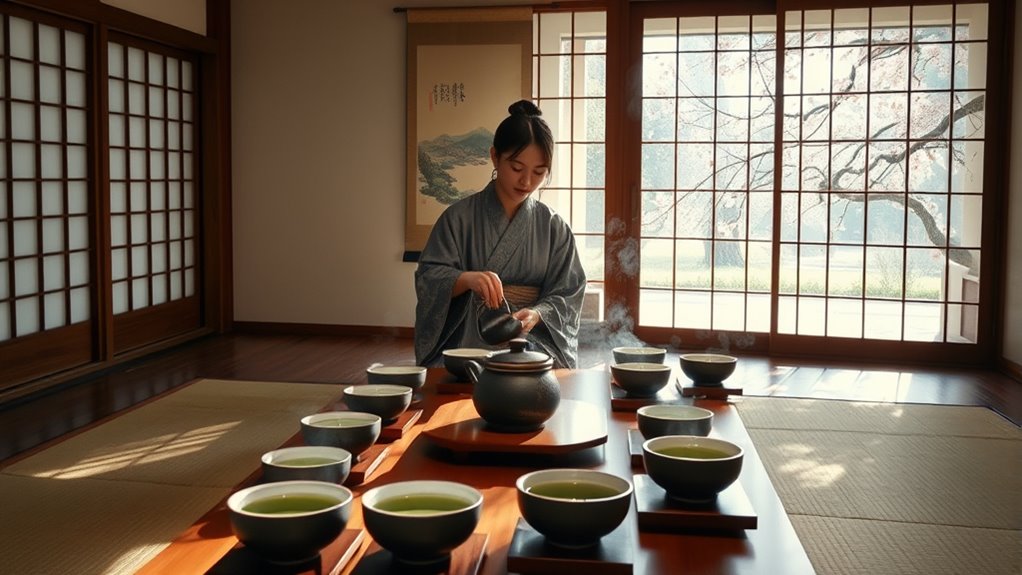
While tea might seem like a simple beverage, its historical significance in Japan runs deep, shaping cultural practices and spiritual beliefs over centuries.
You’ll find that tea was first introduced during the Nara period by Buddhist monks returning from China, initially used in ceremonies to symbolize purity and spiritual clarity.
Over time, the Zen monk Eisai popularized tea, emphasizing its health benefits and bringing seeds from China. This led to a gradual spread of tea consumption from the elite to the general populace.
The Zen monk Eisai championed tea for its health benefits, fostering its journey from elite circles to everyday life.
Zen Buddhism further influenced tea culture, integrating mindfulness and meditation into its rituals. Japanese tea consumption is part of religious rituals and daily life in Japan, highlighting its integral role in societal practices.
The tea ceremony, with its focus on simplicity and nature, became a vital expression of Japanese social and spiritual values, reflecting harmony and respect.
Exploring Different Varieties of Japanese Tea
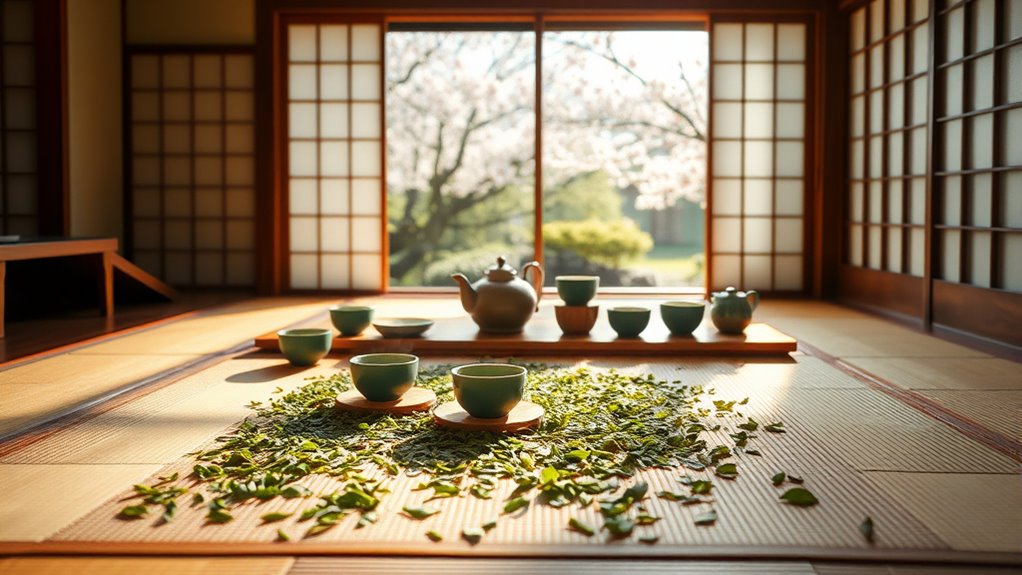
Japanese tea offers a remarkable array of flavors and varieties, each reflecting the region’s unique climate and cultivation techniques.
You’ll discover the vibrant taste of Sencha, the most popular green tea, with its refreshing grassy notes. For a richer experience, try Gyokuro, a premium shade-grown tea boasting intense umami.
If you enjoy something unique, Genmaicha combines green tea with roasted brown rice for a toasty aroma, while Hojicha delivers a smoky flavor thanks to its roasting process.
Don’t overlook Matcha, finely ground and used in ceremonies, or Bancha, harvested later for a lighter taste.
Each type presents its own story, inviting you to explore Japan’s tea culture and savor the nuanced flavors across regions.
The Art of the Japanese Tea Ceremony
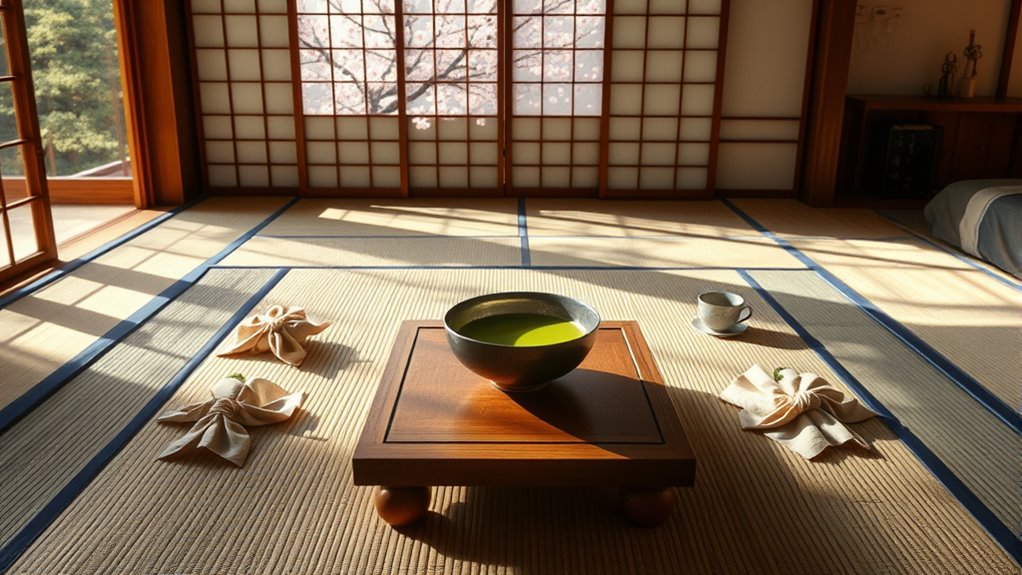
When you step into a traditional Japanese tea ceremony, you’re not just sipping tea; you’re entering a world where mindfulness and artistry intertwine.
This ritual, deeply rooted in Zen Buddhism, emphasizes tranquility and inner peace. As the host prepares the tea, each movement is precise, utilizing tools like the chasen and chashaku to create a harmonious experience.
You’ll appreciate the beauty of the chawan, chosen for its aesthetic appeal. Guests, too, play a vital role, maintaining respectful posture and cleansing their spirits before entering.
The ceremony embodies four essential qualities: harmony, respect, cleanliness, and tranquility, showcasing the rich cultural traditions that have evolved over centuries, making every sip a moment of connection and reflection.
Regional Tea Production and Its Impact
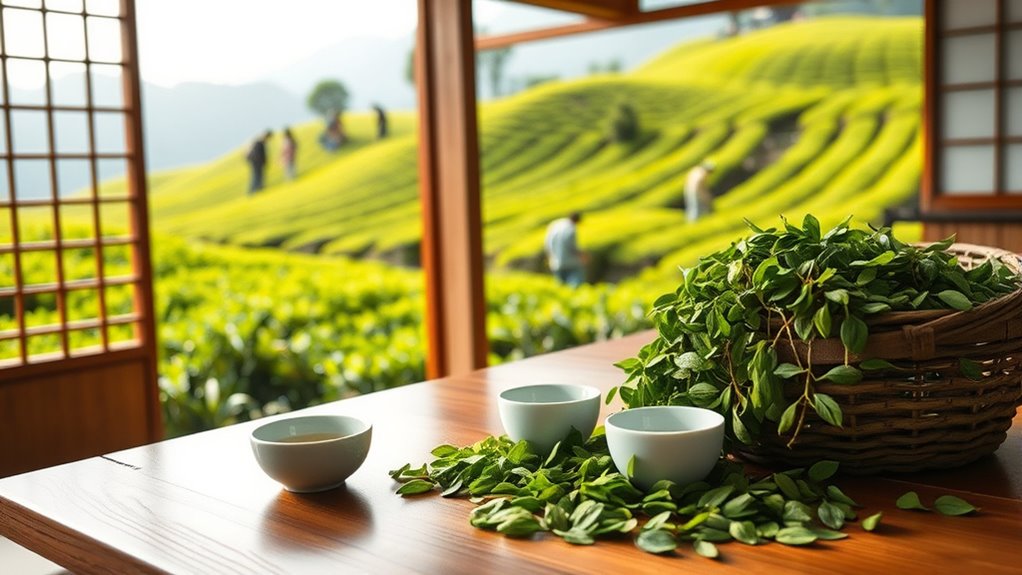
Tea production in Japan significantly shapes the cultural and economic landscape of its regions, as each area boasts unique varieties and flavors that reflect local traditions.
In Shizuoka, you’ll discover light, refreshing Sencha, while Kagoshima offers rich, umami Matcha.
Mie’s Kabusecha delights with its delicate sweetness, and Kyoto’s Uji teas present complex flavor profiles steeped in history.
Fukuoka’s Gyokuro stands out for its deep, creamy taste.
This thriving tea industry creates jobs and drives local economies, enhancing tourism and supporting regional businesses.
Festivals celebrating tea culture not only strengthen community ties but also showcase the craftsmanship behind each brew.
As you explore these regions, you’ll see how tea connects people and enriches their cultural identities.
The Role of Tea Houses in Japanese Culture
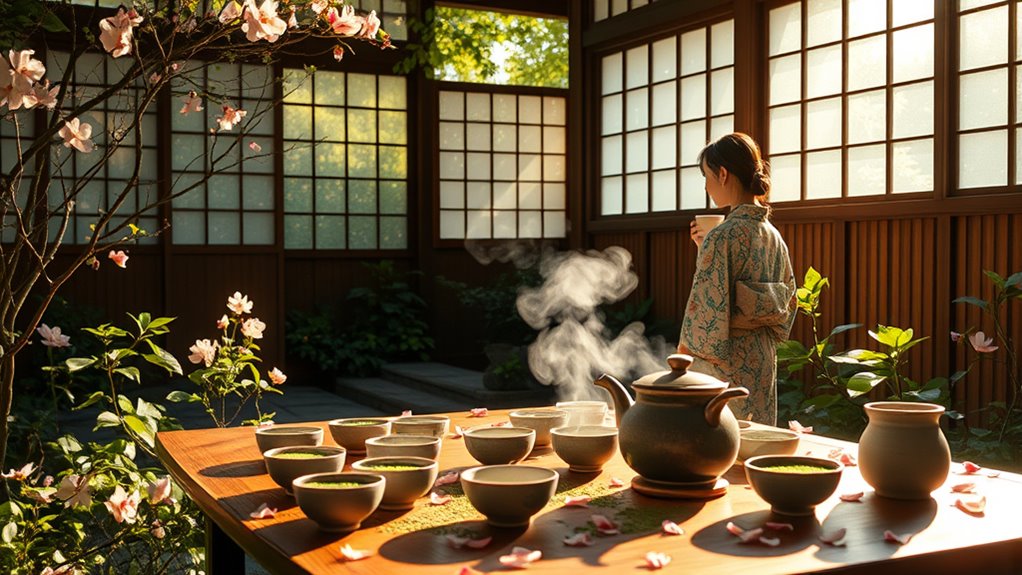
In the rich tapestry of Japan’s cultural landscape, tea houses play a pivotal role in shaping social interactions and preserving traditions. Emerging during the late medieval period, these spaces fostered communal experiences along main roads. Over time, they evolved, incorporating various forms of entertainment, though many have declined in modern society.
The Zen influence is evident in their architecture, emphasizing simplicity and tranquility. Traditional tea houses, or *chashitsu*, feature tatami mats, shōji windows, and a tokonoma alcove, embodying the *wabi-sabi* philosophy that appreciates natural beauty.
These venues not only host tea ceremonies but also serve as community centers, showcasing traditional arts and strengthening social bonds, ultimately preserving Japan’s rich cultural heritage for future generations.
Seasonal Influences on Tea Tasting Experiences

As the seasons change, so do the experiences and flavors of tea tasting in Japan, creating a dynamic ritual that reflects nature’s cycles.
In spring, you’ll savor lighter matcha varieties, bursting with floral notes. As summer arrives, refreshing chilled teas take center stage, perfect for hot days.
In autumn, creamy and toasty blends mirror the warm hues of falling leaves. Winter brings richer teas, enjoyed around a charcoal brazier for warmth.
Special events like Hanami and Tsukimi shape your tasting experience, while seasonal displays and sweets enhance each ceremony.
With each sip, you’ll appreciate the unique flavor profiles that evolve throughout the year, making every tea tasting a celebration of the changing seasons.
Health Benefits of Japanese Green Tea
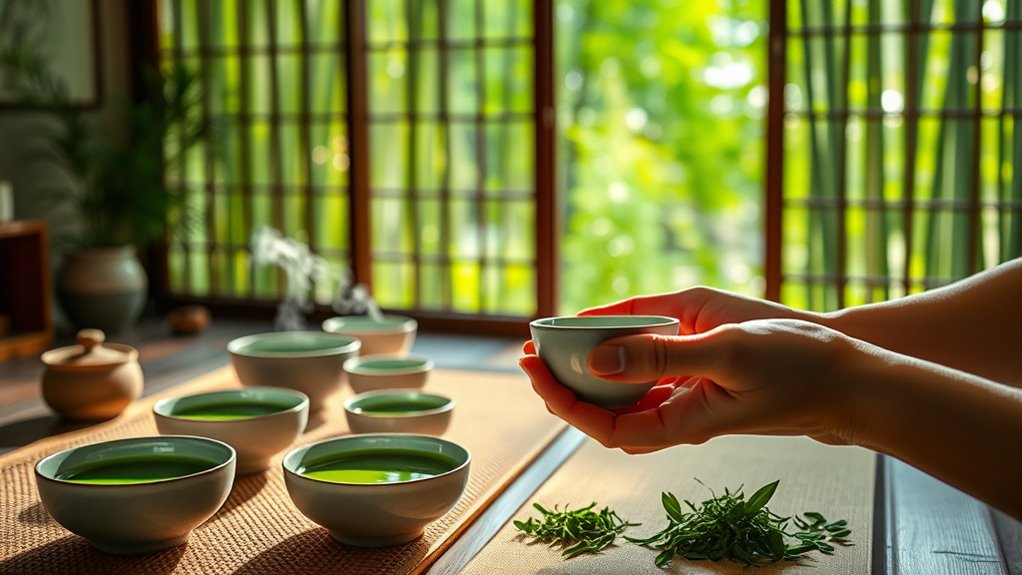
While sipping Japanese green tea, you’re not just enjoying a delightful beverage; you’re also reaping a wealth of health benefits. This tea is packed with antioxidants, particularly catechins, which fight stress and boost cell health.
Regularly drinking green tea can enhance your immune system, helping you fend off common illnesses. Plus, the combination of catechins and caffeine supports metabolism, aiding in weight loss and fat burning.
You’ll also appreciate its heart health benefits, as it may lower cholesterol and reduce heart disease risk. With anti-inflammatory properties, green tea can help alleviate chronic inflammation.
Cultural Immersion Through Tea Tasting Activities
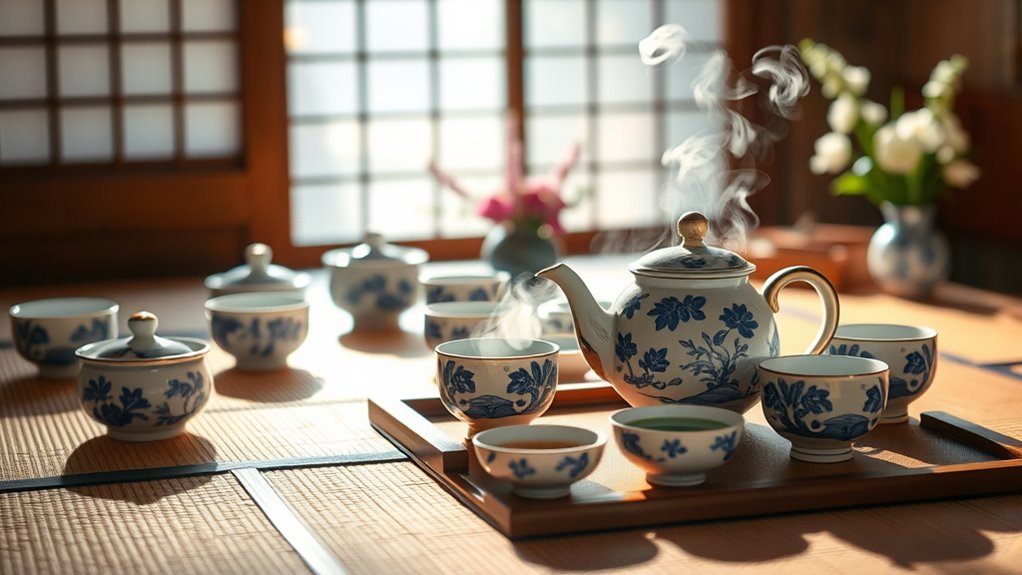
Experiencing tea tasting in Japan immerses you in a rich tapestry of culture and tradition, where each sip reveals a story.
Immerse yourself in Japan’s tea tasting, where each sip unfolds a captivating story of culture and tradition.
You’ll discover the historical roots of tea ceremonies, tied to Zen Buddhism and samurai alliances, showcasing the significance of tea in Japanese society. As you savor diverse varieties like sencha and matcha, expert guides will help you appreciate the unique flavors and regional differences.
Participating in a ceremony while adorned in a kimono enhances your cultural experience, inviting mindfulness and respect. You’ll also enjoy seasonal wagashi, perfectly paired with tea, while learning about the intricate etiquette involved.
This hands-on experience offers invaluable insights into Japan’s history and customs, enriching your cultural journey.
Popular Locations for Tea Tasting in Japan
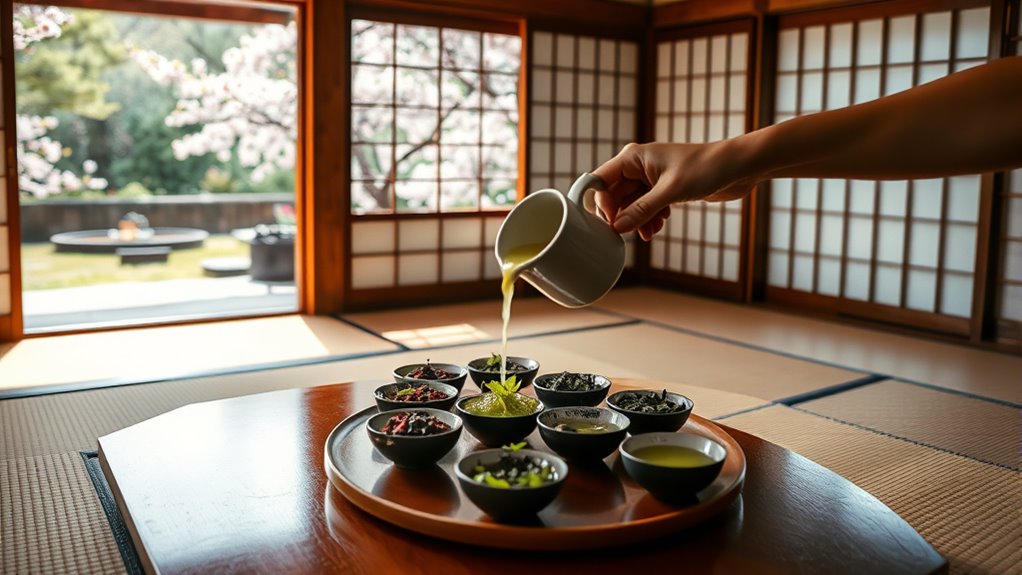
Japan offers a variety of exceptional locations for tea tasting, each with its own unique charm and specialties.
Start your journey in Shizuoka Prefecture, the tea capital, where you can explore scenic tea plantations and pick your own leaves.
In Tokyo, you’ll find diverse tea shops, like Ippodo for luxury matcha or Sakurai, which modernizes the tea experience.
Head to Uji in Kyoto for high-quality matcha and authentic tea ceremonies, often performed by geisha.
If you prefer a quieter setting, Kanazawa’s historical tea houses provide a serene atmosphere.
For something off the beaten path, visit Sakata, where you can enjoy authentic tea houses and immerse yourself in local traditions.
Each location invites you to savor Japan’s rich tea culture.
Frequently Asked Questions
What Should I Wear to a Tea Tasting in Japan?
When you’re heading to a tea tasting in Japan, aim for a balance between comfort and respect.
If it’s formal, consider wearing a simple kimono or a modest outfit that isn’t overly casual. Long skirts or trousers work well, and make sure to wear clean socks, since shoes come off.
For informal settings, smart casual attire is fine, but avoid jeans and T-shirts.
Keep your appearance respectful and in tune with Japanese cultural norms.
How Can I Prepare for a Tea Tasting Experience?
When it comes to preparing for a tea tasting experience, you’ll want to hit the ground running. Start by familiarizing yourself with different Japanese teas like matcha and sencha, so you can appreciate their unique flavors.
Dress appropriately, keeping comfort and tradition in mind. Brush up on basic tea etiquette; it’ll make a world of difference.
Lastly, keep an open mind and be ready to savor each sip – it’s all about the experience!
Are There Etiquette Rules to Follow During Tea Tasting?
Yes, there are etiquette rules to follow during tea tasting.
First, arrive on time and dress conservatively, preferably in traditional attire.
Handle your teacup with both hands and turn it slightly when receiving it.
Bow to express gratitude before and after drinking.
Sip quietly, usually in two or three sips.
If sweets are served, consume them in three bites.
Always show respect for the host and the tea being presented.
Can I Take Photographs During the Tea Ceremony?
Taking photographs during a tea ceremony can feel like trying to capture a fleeting sunset—beautiful but delicate.
It’s best to approach this with caution. Always ask for permission first; many hosts appreciate discretion.
If you do get the green light, avoid using flash, as it can disrupt the serene atmosphere.
Remember, respecting the ceremony’s dignity and the experience of other guests should always come first.
Enjoy the moment instead of just documenting it.
What Are the Best Times of Year for Tea Tasting?
The best times for tea tasting in Japan are during the spring and early autumn.
Spring, especially from April to June, brings the first harvest, Ichibancha, known for its vibrant flavors and high quality. You’ll enjoy fresh teas and traditional ceremonies.
Early autumn, around September, offers the Akibancha harvest, perfect for sampling unique blends.
Both seasons present an excellent opportunity to immerse yourself in Japan’s rich tea culture while tasting delicious varieties.
Conclusion
In Japan, tea tasting isn’t just about sipping; it’s a sensory symphony that blends tradition, taste, and tranquility. From the rich rituals of the tea ceremony to the vibrant variety of leaves, each experience offers a peek into Japan’s profound culture. So, whether you’re wandering through a whimsical tea house or savoring seasonal selections, you’ll find that every cup is a captivating journey. Dive into the delightful world of Japanese tea, and let its flavors flourish in your heart.
